
Incense is an aromatic biotic material that releases fragrant smoke when burnt. The term is used for either the material or the aroma. Incense is used for aesthetic reasons, religious worship, aromatherapy, meditation, and ceremony. It may also be used as a simple deodorant or insect repellent.

Sandalwood is a class of woods from trees in the genus Santalum. The woods are heavy, yellow, and fine-grained, and, unlike many other aromatic woods, they retain their fragrance for decades. Sandalwood oil is extracted from the woods. Sandalwood is often cited as one of the most expensive woods in the world. Both the wood and the oil produce a distinctive fragrance that has been highly valued for centuries. Consequently, some species of these slow-growing trees have suffered over-harvesting in the past.
The economy of South India after independence in 1947 conformed to a socialist framework, with strict governmental control over private sector participation, foreign trade and foreign direct investment (FDI). Through 1960–1990, South Indian economies experienced mixed economic growth. In the 1960s, Kerala achieved above-average economic growth, while Andhra Pradesh's economy declined during this period. Similarly, Kerala experienced an economic decline in the 1970s while the economies of Tamil Nadu, Andhra Pradesh, and Karnataka consistently exceeded national average growth rates after 1970. South India first started to overtake the rest of India economically in the 1980s. Andhra Pradesh, Tamil Nadu and Karnataka were noted by some to be more reform-oriented in terms of economic policy when compared to other Indian states. Over the last decade South India has grown at 8% annually. Future economic growth will be shackled by a relatively low proportion of the active age population to the number of dependents. Today, South India has about 20% of India's population, and contributes about 31% of India's GDP; it is projected to contribute 35% by 2030.
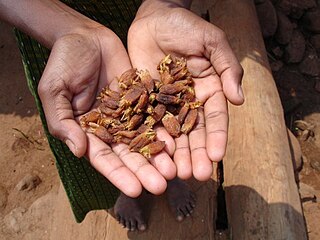
Forest produce is defined under section 2(4) of the Indian Forest Act, 1927. Its legal definition includes timber, charcoal, caoutchouc, catechu, wood-oil, resin, natural varnish, bark, lac, myrobalans, mahua flowers, trees and leaves, flowers and fruit, plants, wild animals, skins, tusks, horns, bones, cocoons, silk, honey, wax, other parts or produce of animals, and also includes peat, surface soil, rocks and minerals etc. when found inside or brought from a forest, among other things.

The burning of incense in Japan began during the 6th century with the introduction of Buddhism, which uses incense during rituals and ceremonies. Agarwood was imported into Japan from China via Korea. From that point on, incense would become an important facet of Japanese culture. Incense is used for a variety of purposes, including Buddhist ceremonies, spirituality and meditation.
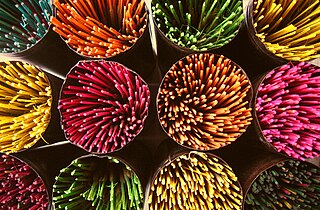
India is the world's main incense producing country, and is also a major exporter to other countries. In India, incense sticks are called Agarbatti (Agar: from Dravidian probably Tamil அகில், அகிர், Sanskrit varti, meaning "stick". An older term "Dhūpavarti" is more commonly used in ancient and medieval texts which encompasses various types of stick incense recipes. Incense is part of the cottage industry in India and important part of many religions in the region since ancient times. The method of incense making with a bamboo stick as a core originated in India at the end of the 19th century, largely replacing the rolled, extruded or shaped method which is still used in India for dhoop.
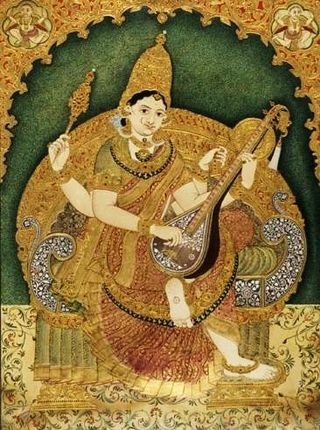
Mysore painting is an important form of classical South Indian painting style that originated in and around the town of Mysore in Karnataka. The painting style was encouraged and nurtured by the Mysore rulers. Painting in Karnataka has a long and illustrious history, tracing its origins back to the Ajanta Caves period. The distinct school of Mysore painting evolved from the paintings during the Vijayanagara Empire period, the rulers of Vijayanagara and their feudatories encouraged literature, art and architecture as well as religious and philosophical discussions. With the fall of the Vijayanagara Empire after the 1565 Battle of Talikota, the artists who were until then under royal patronage migrated to various places such as Mysore, Tanjore and Surpur among others. Absorbing the local artistic traditions and customs, the erstwhile Vijayanagara school of painting gradually evolved into the many styles of painting in South India, including the Mysore and Tanjore schools of painting.

Karnataka has a variety of traditional arts, including folk dance and puppetry.
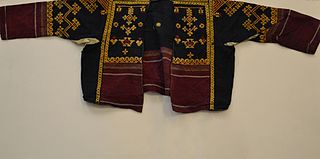
Kasuti is a traditional form of folk embroidery practised in the state of Karnataka, India. Kasuti work which is very intricate sometimes involves putting up to 5,000 stitches by hand and is traditionally made on dresswear like Ilkal sarees, Ravike/Kuppasa(Khana) and Angi. The Karnataka Handicrafts Development Corporation (KHDC) holds a geographical indications (GI) protection for Kasuti embroidery which provides intellectual property rights on Kasuti to KHDC.

Channapatna toys are a particular form of wooden toys and dolls that are manufactured in the town of Channapatna in the Ramanagara district of Karnataka state, India. This traditional craft is protected as a geographical indication (GI) under the World Trade Organization, administered by the Government of Karnataka. As a result of the popularity of these toys, Channapatna is known as the Gombegala Ooru (toy-town) of Karnataka. Traditionally, the work involved lacquering the wood of the Wrightia tinctoria tree, colloquially called Aale mara (ivory-wood).

Byadagi chilli is a variety of chilli mainly grown in the Indian state of Karnataka. It is named after the town of Byadgi which is located in the Haveri district of Karnataka. It is sometimes written as Bedgi in some supermarkets and grocery stores in India. The business involving Byadagi chillis has the second-largest turnover among all chilli varieties of India. An oil, oleoresin, extracted from these chillies is used in the preparation of nail polish and lipstick. Byadagi chilli is also known for its deep red colour; it is less spicy and is used in many food preparations of South India. Byadagi chilli has been accorded Geographical Indication (GI) in February 2011. Its GI tag is 129.
Mysore Sandal Soap is a brand of soap manufactured by the Karnataka Soaps and Detergents Limited (KSDL), a company owned by the government of Karnataka in India. This soap has been manufactured since 1916, when Krishna Raja Wadiyar IV, the king of Mysore, set up the Government Soap Factory in Bangalore. The main motivation for setting up the factory was the excessive sandalwood reserves that the Mysore Kingdom had, which could not be exported to Europe because of the First World War. In 1980, KSDL was incorporated as a company by merging the Government Soap Factory with the sandalwood oil factories at Shimoga and Mysore. Mysore Sandal Soap is the only soap in the world made from 100% pure sandalwood oil. KSDL owns a proprietary geographical indication tag on the soap, which gives it intellectual property rights to use the brand name, to ensure quality, and to prevent piracy and unauthorised use by other manufacturers. In 2006, Mahendra Singh Dhoni, the Indian cricketer was selected as the first brand ambassador of the Mysore Sandal Soap.
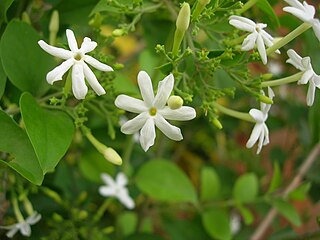
Jasmine is considered the queen of flowers and is called the "Belle of India" or the "Queen of fragrance" as it is exquisitely scented to soothe and refresh. In different parts of India it is called by different names—Mogra, Motia, Chameli, Malli puvvu, Jaati, Mulla, Mallige, Juhi, Mogra or Moonlight in the grove. It is reported that there are 300 varieties of jasmine. It is also stated that jasmine crossed the seas—from Asia to Europe, landing first along the Mediterranean Sea, conquering Greece and Turkey, reaching Western Europe through Spain, then France and Italy and finally landing in England in the latter part of the 17th century..

Incense in China is traditionally used in a wide range of Chinese cultural activities including religious ceremonies, ancestor veneration, traditional medicine, and in daily life. Known as xiang, incense was used by the Chinese cultures starting from Neolithic times with it coming to greater prominence starting from the Xia, Shang, and Zhou dynasties.

Inksticks or ink cakes are a type of solid Chinese ink used traditionally in several Chinese and East Asian art forms such as calligraphy and brush painting. Inksticks are made mainly of soot and animal glue, sometimes with incense or medicinal scents added. To make ink, the inkstick is ground against an inkstone with a small quantity of water to produce a dark liquid which is then applied with an ink brush. By adjusting the strength and duration of the ink grinding process, artists and calligraphers may adjust the concentration of the produced ink to suit their tastes.
Karnataka Soaps and Detergents Limited (KSDL) is an Indian company, owned by the Government of Karnataka, that manufacturers personal care products including Mysore Sandal Soap. It was founded as Government Sandalwood Oil Factory in 1916 by Maharaja Krishna Raja Wadiyar IV and M. Visvesvaraya for extracting and exporting sandalwood oil. It launched Mysore Sandal Soap in 1918, and has since manufactured soaps and cosmetics products. The company became a public sector enterprise in 1980 and was renamed as KSDL.
Molakalmuru Saree, also known as Karnataka Kanchipuram, is the traditional silk saree that is weaved in Molakalmuru, Chitradurga district, Karnataka, India. In 2011, it was granted a Geographical Indication tag and its tag number is 53. The motifs include that of fruits, animals, and flowers.

Mysore Sandalwood Oil is a trademarked perfume oil extracted from the Santalum album variety of sandalwood tree in the Mysore district of Karnataka, India. The tree species is said to be one of the best varieties in the world.
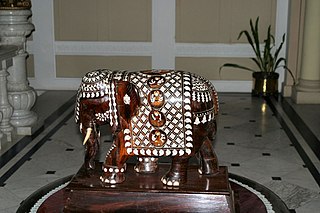
Mysore Rosewood Inlay covers a range of techniques used by artisans in around the area of Mysore in sculpture and the decorative for inserting pieces of contrasting, often coloured materials like ivory shells, mother-of-pearl, horn and sandalwood into depressions in a rosewood object to form ornament or pictures that normally are flush with the matrix. These artifacts are manufactured in around the region of Mysore, these artifacts have been awarded Geographical Indication tag from the Government of India in 2005 due to its historic representation as an artifact depicting the region and the design and style used by the local artisans















